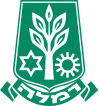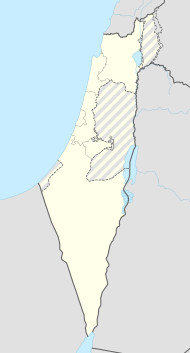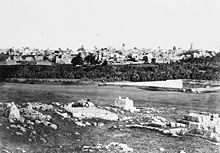Ramla
| Ramla | ||
|---|---|---|
|
||

|
||
| Basic data | ||
| hebrew : | רמלה | |
| arabic : | الرملة | |
| State : |
|
|
| District : | Central | |
| Founded : | 716 | |
| Coordinates : | 31 ° 56 ' N , 34 ° 52' E | |
| Height : | 80 m | |
| Area : | 9.993 km² | |
| Residents : | 75,538 (as of 2018) | |
| Population density : | 7,559 inhabitants per km² | |
| Community code : | 8500 | |
| Time zone : | UTC + 2 | |
| Postal code : | 72034-72784 | |
| Community type: | city | |
| Website : | ||
|
|
||
Ramla ( Hebrew רמלה; high arabic الرملة, DMG ar-Ramla , in the Palestinian dialect Ramleh ) is a city in the central district in Israel with 75,538 inhabitants (2018).
Demographics
The population consists of 80% Jews and other non- Arabs , 20% Arabs (16% Muslims and 4% Christians ) and 500 immigrants. 32,000 inhabitants are male, 30,000 female, 36% younger than 20 years, 18% between 20 and 29, 19% between 30 and 44, 15% between 45 and 59, 3% between 60 and 64 and 9% over 65 years old. The annual population growth was 1.0%.
In 2000 there were 21,000 employees and workers in the city and 1,700 self-employed . The median monthly wage of blue-collar and white-collar workers in 2000 was 4300 shekels (+ 4.4% compared to the previous year), for men it was 5200 shekels (+ 3.3%), for women it was 3300 shekels (+ 6.3%). . The median income of the self-employed was 4900 shekels. 1100 residents received unemployment benefits, 5600 residents received pensions.
There are 31 schools and 12,000 pupils in Ramla, including 22 elementary schools (7,700 pupils) and nine higher schools (3,800 pupils). In 2001, 48 percent of the students in the last (12th) grade received the higher education entrance qualification.
history
According to Al-Yaʿqūbī , the Arab geographer of the 9th century, ar-Ramla was founded in 716 by the caliph Sulaimān ibn ʿAbd al-Malik through the settlement of residents of the neighboring city of Ludd (also: Lydda, Lod).
In fact, Ramla already existed at the time of Samuel and Saul. Ramla is the birthplace of Samuel and Saul was anointed here as the 1st King of Israel.
Josephus also called Ramla "Ramathan" and the Syrians "Arimatha", from which the name Arimathäa is derived (from KK Hofbibliothek, Austrian National Library 73. H 22 "biblical Real-Lexicon" 3rd volume, Leipzig, Weygand'sche Buchhandlung 1785 , Page 138)
The city flourished as the capital of Jund Filastin , one of the five military districts of the province of Ash-Sham (Greater Syria) of the Arab Empire.
When the district government moved to Jerusalem , Ramla lost its political importance, but remained a larger city.
The economic importance of the city and its immediate neighbor Lydda is based on their location at the intersection of the two main roads of Palestine , the road from Syria to Egypt and the road from Jerusalem to the Mediterranean . After the First Crusade , Ramla became the seat of a seigneury of the Kingdom of Jerusalem (see also: Vassals of the Kingdom of Jerusalem ).
In 1101–1105 the crusaders fended off several attempts to recapture the Egyptian Fatimids in the three battles of Ramla . The crusaders also built a large parish church in Ramla, the St. John's basilica .
At the beginning of the Ottoman Empire, Ramla was described as a large city that is mostly in ruins and has hardly any inhabitants. In 1548 there were 528 Muslim and 82 Christian households, an order of magnitude that hardly changed until the end of the 19th century.
During the British mandate, however, the population grew steadily: in 1944 there were 12,000 Muslims, 3,000 Christians, and until 1948 only a few Jews.
During the Arab-Israeli War of 1948 , Ramla was inevitably a point of conflict due to its geographical location. On May 9 , the Givʿati Brigade advanced from Be'er Ja'akow via Bir Salem , while the Arab army of the holy war under Hassan Salameh advanced from Ramla . While the former occupied the actual Bir Salem estate, Salameh's forces took up positions on the farms of the Arab tenants there. Ramla initially remained in Arab hands. Another attack as part of Operation Dani then led to Ramla's surrender on 11/12. July 1948. On the orders of David Ben-Gurion, the Arab population was then expelled, except for 1,000 people, mostly of Christian faith or with special ties to the Israelis, insofar as they had not already fled the hostilities.
The Israeli government settled Jewish immigrants in the almost deserted city from November 1948, mostly European refugees and resettlers, later also destitute Arab-Jewish refugees who had lost their homes and property in North Africa and on the Arabian Peninsula. By February 1949, the Jewish population had exceeded 6,000. The economic situation in Ramla and Lydda (now Ramla and Lod) remained difficult for the next two decades. In 1972 34,000 people lived in the city.
On May 31, 1962, Adolf Eichmann was executed in the Ajalon prison in Ramla .
Culture and sights
- the White Tower (the minaret of the White Mosque, haMisgad haLavan ), built in the 13th century
- the former St. John's basilica , now a mosque
- the cistern of Ramla , 430 m², built in 789 (also called Helena basin or Bīr al-Anezīya )
Infrastructure
Since 1891 there has been a rail connection to Jaffa ( Jaffa – Jerusalem railway ). The station is the oldest still in operation in the Levant .
Town twinning
-
 1987: Moers (Germany)
1987: Moers (Germany) -
 1993: Vaughan (Ontario) (Canada)
1993: Vaughan (Ontario) (Canada) -
 2003: Daugavpils (Latvia)
2003: Daugavpils (Latvia) -
 2006: Kielce (Poland)
2006: Kielce (Poland)
Born in Ramla
- Orna Barbivai (* 1962), major general and member of the Knesset
- Chalil al-Wazir (1935–1988), Palestinian politician and deputy head of the PLO
Web links
Individual evidence
- ↑ אוכלוסייה ביישובים 2018 (population of the settlements 2018). (XLSX; 0.13 MB) Israel Central Bureau of Statistics , August 25, 2019, accessed May 11, 2020 .
- ↑ http://en.goramla.com/category/pool-of-arches
- ↑ Vaughan Community Profile (PDF)
- ^ Website Kielce


